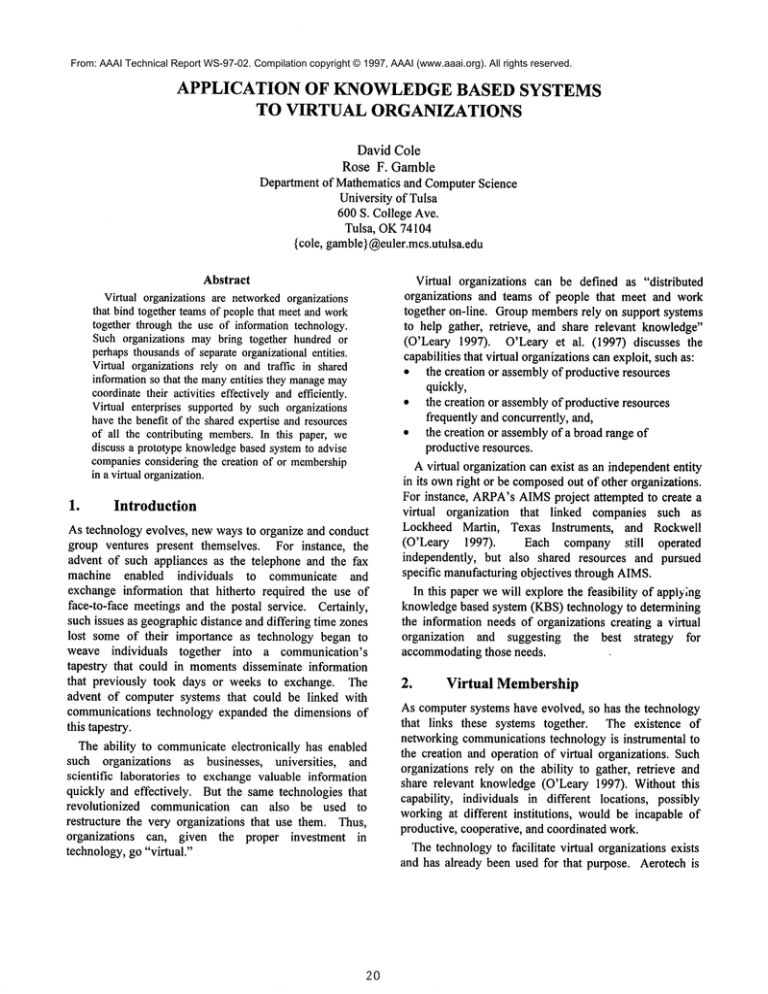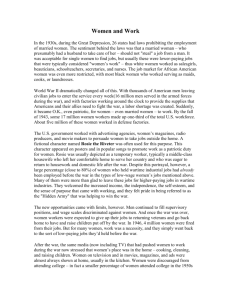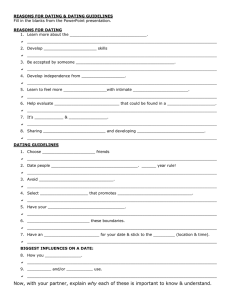
From: AAAI Technical Report WS-97-02. Compilation copyright © 1997, AAAI (www.aaai.org). All rights reserved.
APPLICATION OF KNOWLEDGE BASED SYSTEMS
TO VIRTUAL ORGANIZATIONS
David Cole
Rose F. Gamble
Department of Mathematics and ComputerScience
University of Tulsa
600 S. College Ave.
Tulsa, OK74104
{cole, gamble}@euler.mcs.utulsa.edu
Abstract
Virtual organizations are networkedorganizations
that bind together teamsof people that meetand work
together through the use of information technology.
Such organizations maybring together hundred or
perhapsthousandsof separate organizationalentities.
Virtual organizations rely on and traffic in shared
informationso that the manyentities they managemay
coordinatetheir activities effectively andefficiently.
Virtual enterprises supported by such organizations
havethe benefit of the sharedexpertise and resources
of all the contributing members.In this paper, we
discuss a prototype knowledgebasedsystemto advise
companiesconsidering the creation of or membership
in a virtual organization.
1.
Introduction
As technology evolves, new ways to organize and conduct
group ventures present themselves. For instance, the
advent of such appliances as the telephone and the fax
machine enabled individuals
to communicate and
exchange information that hitherto required the use of
face-to-face meetings and the postal service. Certainly,
such issues as geographic distance and differing time zones
lost some of their importance as technology began to
weave individuals together into a communication’s
tapestry that could in momentsdisseminate information
that previously took days or weeks to exchange. The
advent of computer systems that could be linked with
communications technology expanded the dimensions of
this tapestry.
The ability to communicateelectronically has enabled
such organizations as businesses, universities,
and
scientific laboratories to exchangevaluable information
quickly and effectively. But the same technologies that
revolutionized
communication can also be used to
restructure the very organizations that use them. Thus,
organizations can, given the proper investment in
technology, go "virtual."
20
Virtual organizations can be defined as "distributed
organizations and teams of people that meet and work
together on-line. Group membersrely on support systems
to help gather, retrieve, and share relevant knowledge"
(O’Leary 1997). O’Leary et al. (1997) discusses
capabilities that virtual organizationscan exploit, such as:
the creation or assemblyof productive resources
quickly,
¯ the creation or assembly of productive resources
frequently and concurrently, and,
¯ the creation or assemblyof a broad range of
productive resources.
A virtual organization can exist as an independententity
in its ownright or be composedout of other organizations.
For instance, ARPA’sAIMSproject attempted to create a
virtual organization that linked companies such as
Lockheed Martin, Texas Instruments,
and Rockwell
(O’Leary 1997).
Each company still
operated
independently, but also shared resources and pursued
specific manufacturing objectives through AIMS.
In this paper we will explore the feasibility of applfing
knowledgebased system (KBS)technology to determining
the information needs of organizations creating a virtual
organization and suggesting the best strategy for
accommodatingthose needs.
2.
Virtual Membership
As computer systems have evolved, so has the technology
that links these systems together. The existence of
networking communicationstechnology is instrumental to
the creation and operation of virtual organizations. Such
organizations rely on the ability to gather, retrieve and
share relevant knowledge (O’Leary 1997). Without this
capability, individuals in different locations, possibly
working at different institutions, would be incapable of
productive, cooperative, and coordinated work.
The technologyto facilitate virtual organizations exists
and has already been used for that purpose. Aerotech is
but one exampleof a real virtual organization, built on top
of available information sharing technology (Upton
McAfee1996). The issue addressed in this paper is howto
advise a companythat using a virtual organization is in its
best interest for pursing a particular product or service
innovation.
Using criteria gained from Chesbrough& Teece (1996)
it was possible to extract twelve attributes to describe a
proposed innovation. Six attributes apply to autonomous
innovations and six to systemic innovations. These twelve
attributes are representedin Table1: InnovationAttributes.
Facts
1
2.1 The Three Stages of Determining V.O.
Membership
Advising a companyas to the wisdomof using a virtual
organization can be viewedas a three stage process. In the
first stage, the company must determine whether the
innovation it wishes to pursue can be more efficiently and
more effectively developedthrough a virtual organization.
In stage two, the companymust look at the relationships it
shares with other firms to which it will be bound in the
virtual organization developing the company’s new
innovation. Finally, in stage three the company must
determine if its employeescurrently have the information
technology skills and if its computing hardware and
software have the capabilities to support the proposed
innovation’s developmentthrough a virtual organization.
2
3
4
5
2.1.1 Stage 1: Determiningthe Innovation Type
Chesbrough & Teece (1996) discusses two forms
innovation
that companies may wish to pursue.
Autonomousinnovations can be realized without the need
for concurrent innovations to be developed. For instance,
a new fiat top display for a portable computer could be
developed and integrated into existing products without
creating a newPC architecture. A newarchitecture, on the
other hand, wouldbe an exampleof a systemic innovation.
Such an innovation requires complementaryinnovations in
other, closely related areas (such as new chip designs and
manufacturingtechniques, more powerful batteries to drive
the chips, etc.).
Chesbrough & Teece (1996) argue that virtual
organizations are excellent engines in driving autonomous
innovations. Such organizations "coordinate muchof their
business through the marketplace, where free agents come
together to buy and sell one another’s goods and services;
thus virtual companies can harness the power of market
forces to develop, manufacture, market, distribute, and
support their offerings in ways that fully integrated
companiescan’t duplicate." Systemic innovations require
more centralized control of developing technologies and
mayeven require the adoption of new industry standards.
Such innovations are difficult to pursue through virtual
organizations, where the very market forces that enable
success in certain ventures make intensely coordinated
activity difficult.
21
6
Autonomous
Componentis a
single entity in a
larger system
Componentalready
exists in house, but
needs improvement
Process already exists
in house to produce
the component
Component can be
integrated into
existing designs
Component can be
produced based on
existing industry
standards
Other companies
already produce a
similar component
Systemic
Componentis a
composite entity
Component doesn’t
exist in house;first
time development
Companyhas no in
house process to
produce the
component
Componentrequires
new system designs
for integration
Industry standards
don’t exist for the
component
Production methods
must be invented
industry-wide
Table 1: Innovation Attributes
Usingthese attributes, it is possible to describe a new
innovation in terms of its autonomous and systemic
qualities. Oncean innovationis thus described, the kJad of
innovation being pursued can be determined by tallying
the autonomousattributes and the systemic attributes.
Consideran innovationI, attributes a~ and si where(1 < i _<
6) and each attribute a~ and s~ is either 1 if the attribute
applies to the innovation, 0 otherwise.
If E~= ~ 6 ai > ~i = l.. 6 Si then the innovationis considered
autonomous. Otherwise, it is considered systemic.
Systemic innovations are not appropriately pursued
through virtual organizations. Weuse the above formula
to accommodatemixed innovations that may have features
of both autonomousand systemic innovations.
2.1.2 Stage 2: Determining the Nature of Company
Relationships
Virtual organizations bind together companies that have
agreed to coordinate activity based on shared information
and resources. The extent to which these companieshave
agreed to collaborate (i.e., howmuchthey are willing to
share) determines the stage of their relationship. Upton
McAfee(1996) describe three stages, or degrees,
relationship that can exist between two companies. These
stages of relationship are termed "dating," "engaged," and
"married."
Usingthe criteria found in Upton&McAfee(1996), it
possible to deduce 8 different definitions of these
relationship stages. In Table 2: Relationship Definitions,
we showthese 8 definitions and the relationship stages to
which they are associated.
Dating
Definition 1
Twocompanies are researching each
other’s business histories and practices.
Dating
Definition 2
Twocompanies are exchanging bids and
orders, but neither have accepted.
Dating
Definition 3
Engaged
Definition 1
Twocompanieshave recently entered a
customer/supplier relationship, but the
quality of the relationship has yet to be
determined.
Twocompanies have an established
customer/supplier relationship.
Engaged
Definition 2
Married
Definition 1
Twocompanies are sharing
manufacturing process information.
Twocompanies have visibly committed
to a continuingrelationship.
Married
Definition 2
Twocompanies share data about
production, inventory and schedules.
Married
Definition 3
Twocompaniescan access applications
and information on each other’s
computers.
organizations.
It is the virtual organization that
coordinates and brokers the information that is used by its
members. In doing so, the virtual organization must
contend with specific factors involved in determining
information sharing needs between memberorganizations.
Technologies such as EDI, groupware and WAN’sdo not
and cannot adequately address these factors.
Upton & McAfee (1996) represent
a company’s
information technology sophistication by considering:
The average level of computer expertise among
companypersonnel,
The highest level of computer expertise among
companypersonnel,
¯
The type and power of installed
hardware and
software,
¯
The degree to which employeesare already connected
by an internal network.
Using the above considerations Upton & McAfee(1996)
establish categories with which to represent a company’s
information technology (IT) sophistication. In this paper,
the first two of the aboveconsiderations (i.e., average and
highest level of computerexpertise) are used to determine
a company’s IT expertise. IT expertise is, thus, a
compositeof these two considerations. Similarly, the other
two considerations (i.e., the powerof hardware/software
and the connectivity of the internal network) form
composite that is used to determine a company’s
computing power capabilities.
If the above four
considerations are ranked (say, from 1 - 9), then the
composites of these ranks yield the categories four:d Jn
Table 3: IT Sophistication Levels.
Table 2: Relationship Definitions
Using the above definitions, facts about a relationship
can be used to infer that relationship’s stage. For instance,
if two companiesshare offices, then an inference can be
madethat associates this fact with "married definition 1"
above, i.e. that the two companieshave visibly committed
to a continuing relationship. It is possible to consider any
numberof different relationship facts, as long as those
facts can be related to one of the abovedefinitions.
Information
Technology
Expertise
Capability of Computing
Power
Na’fve
Knowledgeable
Expert
Simple Data Transmission
Shared Data Access
Telepresence/
Access
Applications
to
Table3: IT Sophistication Levels
2.1.3 Stage 3: DeterminingIn-HouseIT Sophistication
Many non-virtual companies have invested heavily in
technologies that allow for electronic collaboration similar
to that which occurs in virtual organizations. Suchsystems
rely on technologies such as EDI, groupware and WAN’s.
However,none of these technologies can individually or in
any combination fully facilitate a virtual organization
(Upton & McAfee1996). The reason lies in the role of
virtual organization
within a network. A virtual
organization has the unique responsibility of satisfying the
information sharing needs of all possible member
22
Wedefine the abovecategories as follow:
Na’fve
Companyemployees are not
accustomed networked work groups
or using remotelylocated application.
Knowledgeable
Companyemployees are accustomed
to workingin groups that
electronically share data, but do not
use remoteapplications.
Expert
Simple Data
Transmission
Shared Data
Access
Telepresence/
Access to
Applications
¯
¯
Companyemployees can work
electronically in groups and use
networkedapplications remotely.
Companycomputers support simple
data transfers, such as ftp.
Companycomputers can directly
access shared data on other
computers.
Companycomputers can support and
use remoteserver applications.
¯
3.
Onceagain, the categories in Table 3 can be derived by
using two composite ranking. One is derived from the
average level of computer expertise among company
personnel and the highest level of computer expertise
amongcompanypersonnel. The other is derived from the
type and powerof installed hardware and software and the
degree to which employees are already connected by an
internal network.
2.2 Role of a Virtual Organization
Upton & McAfee (1996) describe the three factors
involved in determining information sharing needs that
must be managedby a virtual organization. They are:
¯ Stage of relationship, determined in Stage 2 above,
¯ Lowest common denominator
of information
technology (IT) sophistication, determined in Stage
above,
¯
Level of functionality, determinedin Stage 3 above.
These factors are represented in tabular format below in
Table 4: Information Sharing NeedsConsidered.
Factor One [ Factor Two
Dating
Naive
Engaged
Knowledgeable
Married
Expert
I Factor Three
Data Transmission
Shared Data
Access
Telepresence
Innovation to be pursued,
The nature of all companyrelationships within the
virtual organization,
The sophistication of a company’suse of information
technology.
Knowledge Based System Application
The value of a KBSin this domainis that the decision to
create or join a virtual organization can be very profitable
or very costly to a company,depending on the innovation
it is pursuing. Wehave constructed a prototype KBSthat
can be used as a virtual organization "advisor." The
prototype is implemented in CLIPS 6.01. There are 32
working memorytemplates and 65 rules. The KBShas
three main tasks that are analogous to the membership
categories discussed in Section 2. The process overviewis
presented in Figure 1.
Determine Innovation Type
(Autonomous
or Systemic.)
I
continuesif innovation
type is autonomous
only
Determine Potential or Existing
Virtual Organization Relationships
(Dating, Engaged,or Married)
Determine Level of Information
Technology Expertise
(Naive, Knowledgeable,
Exper}
and Capability of Computing Power
(DataTransmission,SharedDataAccess,
Telepresence
)
Table 4: Information Sharing Needs Considered
A virtual organization should be able to integrate
companies at any relationship stage, at any level of
functionality and all but the most na’fve IT users. To do so,
the virtual organization must employinformation sharing
technology that can facilitate the interaction that results
from any combination of the above factors. Technology
that is capable of handling all combinationsof factors is
said to create an "information brokered inter-network"
(Upton & McAfee1996).
Thus, organizations that wouldlike to "go virtual" must
consider three aspects:
23
Make Final Recommendations ]
Figure 1: Tasks of KBSVirtual Organization Advisor
J CLIPSis distributed by COSMIC,
University of Georga,
Athens, GA.
3.1 Determining the Innovation Type
The In"st task in Figure 1 determines if the user’s company
requests an innovation type of Autonomousor Systemic.
The user enters facts according to the criteria discussed in
Section 2. The knowledge base simply counts how many
of the criteria are satisfied. If there is a clear majority
criteria satisfying one innovation type over the other, the
system makes the choice in favor of the majority. In the
event of no clear majority, the KBSresponds with a
Systemic innovation type.
3.2 Determining the Virtual Organization
Relationships
Relationship Definition
Dating 1
Otherfirm is established
supplier
Otherfirm is established
customer
Cross-license patents
Shared cost information
Sharedjoint design of
data definitions and
formats
Engaged 1
Shared long range
planning
Involved in a consortium
Married 1
Married 1
Married 1
Married 1
Married 2
Married 2
Married 3
Married 3
Table 5: Templatesfor Relationship Attributes
The second task in Figure 1 determines the dating,
engaged, or married relationships between the user’s
company and the other prospective companies in the
virtual organization. A template is constructed for each of
17 attributes that help to determine the relationship
according to the definitions for dating, engaged, and
married discussed in Section 2. Upton & McAfee(1996),
Davidow & Malone (1992) and Konsynski & McFarlan
(1990) were used to develop these 17 attribute templates.
The user can assert one or more attribute templates for
each firm with which her/his companywill be boundin the
virtual organization. Table 5 shows the attributes and to
which relationship definition a TRUEvalue for the
attribute corresponds.
Attribute
Exchanging information
about products and
services
Request and receive bids
and quotes from each
other
Currently establishing
contracts and purchase
orders
Established conflict
resolution strategy
Shared office
Shared "commonvision"
Joint research conducted
Electronic interchange
agreement
Shared common
database
Shared remote computer
usage
Dating 2
Dating 3
Templates are constructed for each company in the
prospective virtual organizationin orderto establish a tree
of relationship types, in which the root is the user’s
company. The KBS processes the information and
constructs the tree. Thoughthis information is maintained,
generally, it is the highest level of relationship that is
important in the fmal recommendation.
3.3 Determining Information Technology
Expertise and Computing Power
For this task, the user supplies a set of rankings for the
companythat correspond to the following criteria:
¯ Average computer expertise
¯ Highest level of computerexpertise
¯ Computing power
¯
Current network connectivity
Initially, we allowed for a range of 1..9 per criteria.
However, the knowledgeaccumulated for determining the
level of information technology expertise and the level of
computing power focused on only a three-level ranking.
The rules take a compositeof the rankings of criteria 1 and
2 to determine if the information technology expertise is
na~’ve, knowledgeable, or expert. In the same manner, a
compositeof the rankings of criteria 3 and 4 determine if
the capability
of the computing power is data
transmission, shared access, or telepresence. The KBS
rules are generic to allow for additional criteria, rankings,
and moregranularity of conclusions.
Engaged 1
3.4
Engaged 2
Engaged 2
Engaged 2
KBS Recommendation
Oncethe system has determined the highest relationship
stage to be managedby the virtual organization, the user’s
company’sinformation technology expertise and the user’s
company’s computing power capability, the KBSmakes a
recommendationto the user. It infers whether the user’s
companycan create with existing expertise and equipment
a virtual organization to accommodate all of the
company’srelationships. If the companyis deficient in
expertise or equipment, the KBSinforms the user of the
Married 1
24
deficiency, indicates where the deficiency lies, and
indicates that a virtual organization can not currently be
created by the user’s company.
4.
Conclusion
In this paper, we discussed the knowledge engineering
aspects of creating a prototype KBSapplication that
analyzes and advises on virtual organization membership
and structure. The system determines, given a company’s
innovation goals, whethera virtual enterprise is advisable
for the effective and efficient pursuit of those goals. The
system determines the stage of all relationships with which
the companywill be bound in the virtual organization.
The system further determines the level of information
technology sophistication of the user’s company. If the
organization can appropriately create its owninformation
brokered inter-network,
the system makes that
recommendation.Otherwise, the system notes deficiencies
at the company that prevent it from constructing the
network, and thus creating an organization that can
manage all of the company’s virtual relationships in
pursuit of a newinnovation.
The design of a KBSto act as a "virtual organization
advisor" experienced several difficulties.
For example,
the state of knowledge on developing an information
brokered inter-network has not yet been codified. The
management of a virtual organization could feasibly
involve thousands of individual companies, all of which
must be integrated using existing technology. Current
research in AI and virtual organizations continues to
investigate the means to accomplish such integration
(O’Learyet al. 1997). Since manynew techniques are still
being researched and current techniques may be
proprietary information, capturing such knowledgeproved
difficult in the knowledge engineering stage of KBS
development.
Additionally, the KBSdevelopedis not particularly user
friendly. The user must supply a good deal of information
to the systemin a specified format for any analysis to take
place. Instructions would need to be provided to the user
in order for the user to provide attribute values or rankings.
As virtual organizations mature and more studies of the
mechanismsby which virtual organizations are constructed
and managed are conducted, additional information for
knowledgeengineering will be available. The lack of such
information and "expertise" limits the robustness of any
knowledge based system. However, we conclude that
there is a place for this type of system.
References
(Chesbrough & Teece 1996)
25
Chesbrough, Henry W.; and Teece, David J. Whenis
Virtual Virtuous.’? HarvardBusiness Review, JanuaryFebruary 1996: 65-73.
(Davidow & Malone 1992)
Davidow,William H. and Malone, Michael S. 1992.
The Virtual Corporation. NewYork: Harper Collins.
(Hedberg 1995)
Hedberg,Sara Reese. Intelligent Agents: The First
Harvest of Softbots Looks Promising. IEEE Expert
August1995: 6-9.
(Konsynski & McFarlan 1990)
Konsynski, Benn R.; and McFarlan, F. Warren.
Information Partnerships - Shared Data, Shared Scale.
Harvard Business Review Sept.-Oct. 1990:114-120.
(O’Leary 1997)
O’Leary, Daniel E. The Internet, Intranets, and the AI
Renaissance. ComputerJanuary 1997:71-78.
(O’Learyet al. 1997)
O’Leary, Daniel E.; Kuokka,Daniel; and Plant,
Robert. Artificial Intelligence and Virtual
Organizations. Communicationsof the ACMJanuary
1997: 52-59.
(Pape 1995)
Pape, William R. Becominga Virtual Company.
1995. lnc. Technology. 4: 29-31.
(Upton & McAfee1996)
Upton, David M.; and McAfee, Andrew. The Real
Virtual Factory. HarvardBusiness ReviewJulyAugust 1996: 123-133.






